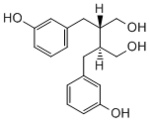
|

|
| Compound | Enterodiol |
| Animal species | human intestinal bacteria Ruminococcus. Sp END-1 and strain END-2 |
| Metabolism parameters | |
| Metabolites |
(+)-Enterodiol (2S, 3S)
(2S,3S)-2,3-bis(3-hydroxybenzyl)butane-1,4-diol (+)-Enterolactone (2S, 3S) (-)-Enterodiol (2R, 3R) (2R,3R)-2,3-bis(3-hydroxybenzyl)butane-1,4-diol (+)-Enterolactone (2R, 3R) |
| Crude drug | |
| References | 1) Jin J. S., Kakiuchi N., and Hattori M.: Enantioselective oxidation of enterodiol to enterolactone by human intestinal bacteria. Biol. Pharm. Bull., 30, 2204-2206 (2007). |
| Remarks | ※LC/MS analysis HPLC/MS was performed on an Agilent 1100 system (Agilent Technologies, Waldbronn, Germany) with a photodiode array detector and an Agilent 1100 series binary pump, and an Esquire 3000plus mass spectrometer (Bruker Daltonic GmbH, Bremen, Germany) coupled with an ESI interface and an ion trap mass analyzer, under the following conditions: column, chiral CD-Ph (Shiseido, Tokyo, Japan, 4.6 mm × 150 mm); mobile phase, 0.1 % TFA (solvent system A) and CH3CN (solvent system B) in gradient modes (B from 30 to 45 % for 30 min); flow rate, 0.5 ml/min; detection, UV at 280 nm; and temperature, 30°C. High-purity nitrogen was used as dry gas at a flow rate of 10 l/min, with temperature of 360°C. Helium was used as nebulizer at 50 psi. The electrospray ionization (ESI) interface and mass spectrometric parameter were optimized to obtain maximum sensitivity. [Jin et al., Biol. Pharm. Bull., 30, 2204-2206 (2007)] ※Incubation of enterodiol (END) with intestinal bacteria and preparation of samples for HPLC A 100 μl portion of precultured Ruminococcus sp. END-1 and strain END-2 was inoculated into 2 ml of GAM broth with 0.2 mM (+)-END and (−)-END, respectively, and the mixture was anaerobically incubated at 37°C for 120 h. A 100 μl aliquot was removed and extracted three times with 100 μl of ethyl acetate. After evaporation of the ethyl acetate in vacuo, the residue was dissolved in 0.3 ml of MeOH. The MeOH solution was filtered through a 0.2 μm membrane filter, and a 10 μl portion was injected onto a chiral column for HPLC analysis. [Jin et al., Biol. Pharm. Bull., 30, 2204-2206 (2007)] |

